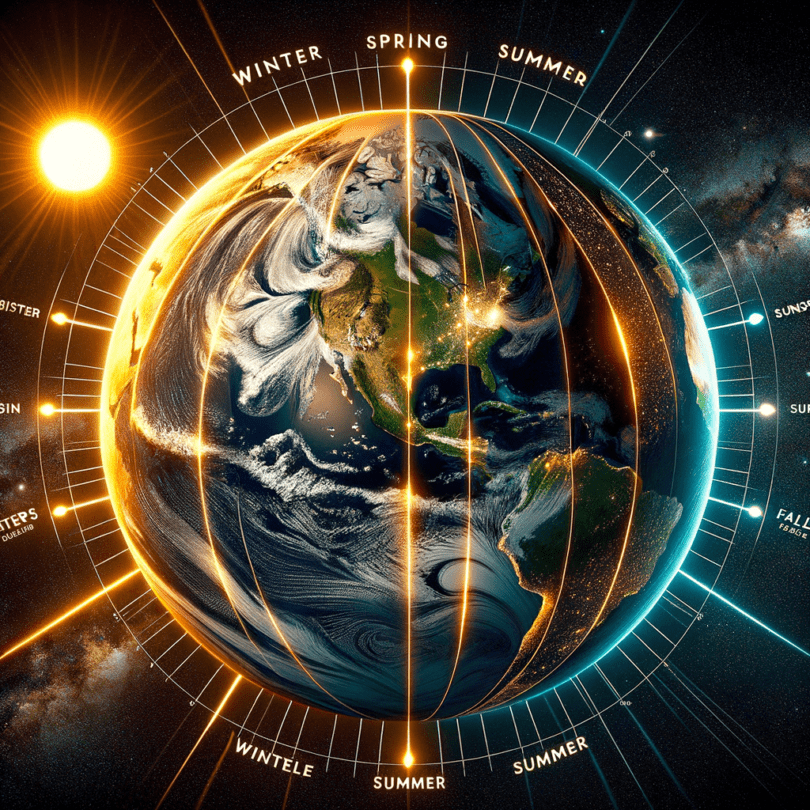Have you ever just sat there and wondered, “Why the heck do we cuddle up in sweaters one part of the year, and then toss them aside to splash in pools a few months later?” I mean, seasons are seriously fascinating! As a kid, I had this wild notion that it was all about how close or far Earth was to the sun. Spoiler: I was way off!
The reality? Our seasons are way cooler (pun intended) because they’re all about Earth’s tilt and orbit. It’s like this amazing cosmic dance that choreographs our winters, summers, springs, and falls. Mind-blowing, right?
Okay, so I’m here, tapping away, trying to take you on this little adventure of why we have seasons. I promise it’s not rocket science, but more like the magical story of our blue planet’s twirl around the blazing Sun.
The Tilt: Earth’s Wobbly Wonder
Imagine this: Earth isn’t spinning like a perfectly twirled top. Nope, she’s got this adorable little lean, tilting at about 23.5 degrees. Guess what? That tilt is the unsung hero of our seasonal saga. Without it, we’d lose the beauty of spring flowers or crunchy autumn leaves.
This tilt is why different parts of Earth get more sunlight than others at different times. It’s kind of like shining a flashlight on your tilted face. Depending on the angle, different bits get more warmth or less. If Earth were perfectly upright, we’d be stuck in a never-ending equinox—talk about boring!
But nah, Earth decided to spice things up! So, here we are, with this tilt that makes sure different parts of us get sunshine at different times. Imagine Earth wearing a jaunty, invisible sombrero, deciding who catches some rays and who gets to chill in the shade.
The Orbit: Earth’s Yearly Spin Around the Block
Our lovely little planet goes on an epic annual trip around the Sun, following an elliptical orbit. Little me thought Earth traveled in a perfect circle, but nope, it’s more like a chubby oval.
Here’s a twist: that oval orbit isn’t the real reason for seasons. You might think being closer to the Sun means sweat city and vice versa, but nah. The distance change isn’t that big to mess up our seasons.
It’s that cheeky tilt again! As Earth makes its orbit, that lean changes the angle of sunshine on different parts at different times. This leaning dance gift-wraps our seasonal shifts.
So, when the Northern Hemisphere tilts toward the Sun, we get summer. Meanwhile, the Southern Hemisphere, pointed away, gets winter. Fast forward half a year, and it’s vice versa. It’s like a cosmic game of see-saw, with each side taking its turn in the sunlight spotlight.
Solstices and Equinoxes: Time’s Checkpoints
In this grand celestial waltz, we get these key moments—solstices and equinoxes—that mark the shift in seasons. They’re like cosmic nods reminding us where we are.
Okay, solstices first. These guys are the drama queens. Twice a year, we hit the Winter Solstice around December 21st—Northern Hemisphere’s longest night and shortest day. Then there’s the Summer Solstice around June 21st—our longest day and shortest night. It’s like the universe saying, “Let’s celebrate extra daylight!”
Then we have the equinoxes—calm, balanced moments. Twice yearly, around March 21st and September 23rd, we get equal day and night worldwide. These mark the gentle slide into spring and autumn, full of beginnings and farewells.
Why It Matters: My Two Cents
All this astronomical stuff isn’t just science facts—it’s about us, woven into the human tapestry. For ages, seasons have shaped culture, driving agriculture, celebrations, and ancient myths. Even our holidays today reflect these rhythms. Easter and Nowruz scream spring, while Christmas brightens the winter gloom.
For me, it’s personal stuff too. Summers spent with family, cozy nights during winter, that fresh school shoe smell come fall, or spring’s enchanting blooms. These memories? They craft our stories. Who’d think a tilted axis and orbiting a Sun could tug at our heartstrings like that!
Seasons Beyond Earth: A Sneak Peek
Seasons aren’t just Earth’s party trick. Other planets join the fray, each with their quirks due to unique tilts and orbits. Mars, similar to us in tilt, has akin seasons but twice as long due to its stretched orbit.
Mercury, though? No tilt, no seasons—just repetitive blah. Venus, with a wonky tilt and spin, has mind-boggling seasons. And Uranus? It’s doing its sideways sashay, giving each pole a 42-year day or night. Total head-scratcher on extreme seasonal vibes!
Reflecting on these wacky versions yanks us back to see our Earth’s unique sweet spot. Our tilt and orbit serve up seasons so seamlessly that they shape our every tradition and vibe.
Wrapping It All Up
So, why do we have seasons? It’s not just bare trees or blooming flowers or ice cream trucks in July. It’s way above, in the Earth’s graceful twirl around the Sun. A tilt, an orbit, a dash of cosmic elegance—all giving rhythm and meaning to our world.
Seasons personally remind me of everything life entails. Change, in all its forms—beautiful, rhythmic, essential. Sometimes we embrace the frost to welcome the warmth. Sometimes endings yield new beginnings. And sometimes, just a tilt in perspective opens us to a world of wonders.
Next time you gripe about chilly air or summer’s sweat, give a nod to our cosmic ballet—the little leans and spins that paint life’s canvas with color and charm.

